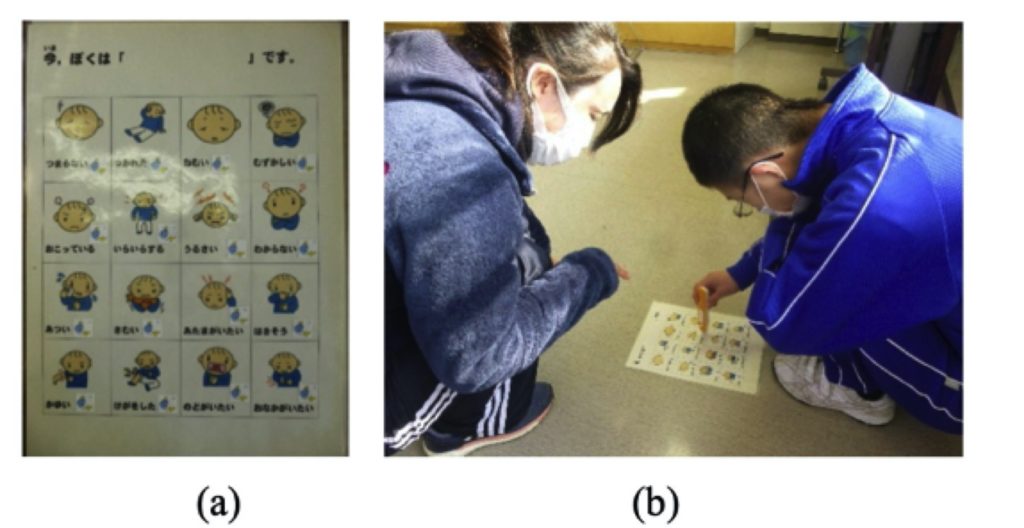Case Study in K-12 Classrooms (Japan)
1. Grade-level and other descriptors
Third-grade junior high school male student
2. Disability (s) and/or needs of the target student
The student has Down syndrome. He could usually understand what he should do and could move smoothly along a daily schedule in school. The student could often help the teacher and his classmates, but he had done his friend’s work without permission and was not good at cooperating with his classmates. He had verbal communication with ambiguous pronunciation and always wanted to communicate with others, but, due to his ambiguous pronunciation, the surrounding persons could not understand what he said. He was glad with what he had performed, but could not recognize what he could not do. At that time, he did not ask anyone for help and therefore could not perform. Then, he threw items and acted violently. It was difficult for him to express his desires with speaking words and phrases. However, he could read Japanese Hiragana characters and some easy Chinese character Kanji that he was used to seeing.
3. Teaching materials and tools used and/or created
By using multimedia-enabled dot codes, the teachers created content beginning with the phrase; “I feel now,” with which the student could express his feelings to the teacher when he became depressed. By touching the Post-it-like sticker icon the teacher pasted on the document with various illustrations by using a speaking-pen, he was able to then tell his feelings to the teachers. The teachers considered that it might be difficult for him to find the suitable illustration that could express his feelings, therefore, they also created two simple communication cards of “Yes!” and “No!” When he was depressed, the teachers asked him, “What happened?” Then, the teachers asked him to select a card and to express his feelings with the help of a speaking-pen.
4. Activities performed for the target student(s)
The student was very much interested in the speaking-pen from the beginning and understood how to use it at once. However, he often refused to use the created content to express his feelings. The teachers repeated speaking to him with easy and gentle phrases; soon he started using the created content to express his feelings. By using the speaking-pen, instead of speaking with ambiguous pronunciation, he gradually started to relax. Touching the Post-it-like sticker icon the teacher had pasted nearby the illustrations of, for example, “Yes,” “No,” “Irritated,” “I didn’t like it,” and “I apologize” sheet (Figure a) enabled him to tell the teacher why he did such things and what he should do next (Figure b).
5. Outcomes attained
The fact that he did not have to speak in his own mouth made him feel at ease and not stubbornly rejecting teachers. Therefore, it was no longer necessary for him to show dislike by problematic behavior. The student passed to the third year of junior high school, where he progressed and tried to tackle a difficult problem that he could not have succeeded by then. In addition, by using this teaching material as a tool for expressing his feelings and communicating with the teacher, the student could face his own feelings himself. This seemed to be because he became able to think what he wanted to do. By tasting the comfort of conveying feelings, the student started to think, together with the teacher, what to do if he did not like anything, even if he stiffened the attitude a little in usual life. The student started moving after confirming to the teacher whether he could act, and gradually became able to cooperate with his classmates.
6. Future issues
This activity stimulated not only problem-solving actions, but also this student’s cognitive growth, thus it became possible to objectively see the self, but not the emotion by using the speaking-pen in the scene which confronts with the self and reconciles the feeling of the self. This student advances to high school. The teachers consider that, in the future, as an adult in the society, it will be necessary for him to raise the quality of his communication by asking for the help when he would be in trouble and accurately telling what he wants to do. The above-mentioned school activity clearly showed that the utilization of electronic equipment such as a speaking-pen was really useful for him as auxiliary equipment to express his thoughts and, thus, live joyfully and safely.

Figure (a) The created sheet pasted with do-code icons and (b) touching the dot-code icon with the speaking-pen G-Speak
7. References
Ikuta, S., Urushihata, C., Saotome, N. & Abe, S. (2020a). School Activities for Disabled Students Using Self-Made Contents With Multimedia-Enabled Dot Codes. In D. Schmidt-Crawford (Ed.), Proceedings of Society for Information Technology & Teacher Education International Conference (pp. 1990-1999).
Posted By Shigeru Ikuta, Senior Scholar of Otsuma Women’s university
Emeritus Professors of Tokyo Metropolitan University & Otsuma Women’s University